Wrinkles in your vinyl liner. Not pretty to look at, and also causes some vinyl liner performance issues. Wrinkles in a vinyl lined pool can create some problems such as:
- Traps dirt up against the folds
- Risk of holes from cleaners snagging a fold
- Weakens the area that is folded
Here’s some of the causes of wrinkles in your liner, and what you can do about it.
Pool liner wrinkles caused by chemicals:
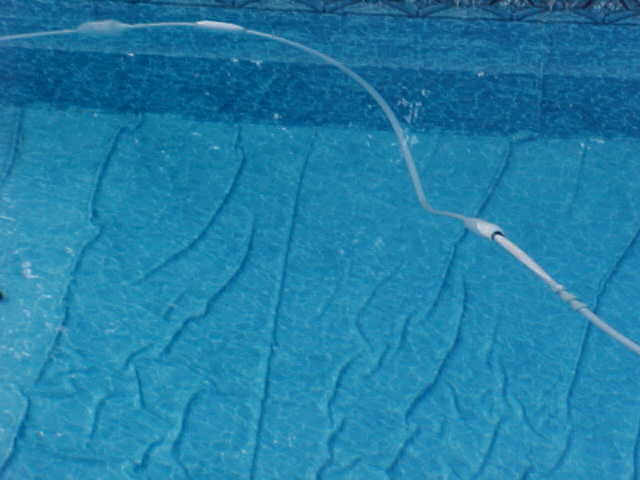
If you keep your pool chlorine level consistently high, or your pool pH level consistently low – you could develop puckering in your pool liner. It can be a localized problem, due to chlorine coming in direct contact with the liner, or it can be widespread. Often this is accompanied by a lightening or bleaching of the vinyl.
Unfortunately, this type of liner wrinkle cannot be reversed, or easily removed. High chlorine and low pH can be very corrosive, and it literally sucks the plasticizer from the vinyl, causing the liner to contract and pucker.
Pool liner wrinkles caused by underground water:

An unfortunate situation, caused by a rising water table, with no topographical escape for the water pressure beneath the pool. Hydrostatic pressure can be so great in rare situations, that it can lift a concrete pool out of the ground – and it can much more easily push up a vinyl liner. It will appear as a bump under the liner, like a giant air bubble. When the water table recedes, the liner will come back down to meet the floor / wall, without wrinkles – if you’re lucky. In many cases, however, the liner wrinkles as the water table drops and the liner comes back into place.
To fix this situation, look toward managing the run-off in the area surrounding the pool. Gutter run-off from the house is always suspect, so look to redirecting the water coming from the downspouts – away from the pool. In some cases, the necessary alterations to the landscape and topography surrounding your pool can be severe to correct the situation. Usually, however, some minor corrections can be made to keep ground water from coming to rest up against the pool.
What Causes Wrinkles in Pool Liners?
- Incorrect Liner Size: A pool liner that is too big, or too deep for the pool size and depth has excess material that folds over.
- Low pool water pH: Over many years’ time, pH levels that are consistently below 7.0 may shrink the liner slightly, due to the acidic water.
- Pool Water Loss: If the water leaks out, or is pumped out of an old liner, the vinyl contracts, making it hard to reset the liner without wrinkles.
- Water Under the Liner: Rare, but high water tables can float a liner, bulging the vinyl liner. When waters recede, wrinkles are possible.
- Puckering:Usually caused by dropping undissolved granular pool chemicals onto the vinyl, or from chlorine tablets resting on a vinyl liner.
- Incorrect Installation: When installing a new liner, as described below, methods are used to prevent vinyl liner wrinkles during and after install.
Pool liner wrinkles when installing a new liner:
This is the most common type of wrinkle in a pool liner. One cause is that the liner ordered is deeper than the pool, or too much additional sand was added while prepping the floor of the pool. A primary cause is poor measurement, especially of the hopper bottom, on inground vinyl liner pools. When installing inground liners, and in some cases aboveground pool liners, using a vacuum or shop vac is necessary to “set” the liner, or suck it tight against the walls and floor, before filling with water. When this step is missed or mishandled, pool liner wrinkles can result.
Overlap pool liners, and in fact all pool liners, should be just slightly above the floor before filling. The best fit of a new pool liner comes from having the liner stretch into place. Not too much of a stretch, or you risk stress and strain on the pool walls and on the liner. Before filling a pool with a new vinyl liner, you should position the liner so that it is off the floor by just an inch or two.
On oval or rectangular pools, having a “twisted” liner can also result in wrinkles while installing a new liner. Make sure to line up corners or the apex of a radius before filling. If you have diagonal wrinkles on the walls, you need to shift the liner in the opposite direction.
Pool wrinkles in a pool liner, caused by “slippage”:
Slippage is my own made-up word, and it occurs on aboveground pools with overlap liners. If you don’t have enough coping clips to secure the liner (securely) to the top of the pool wall, it can slip down the wall. First creating wall wrinkles, which work their way to the floor eventually.
Pool wrinkles caused by underground erosion:
Not a common cause, but in pools with a soft floor and active underground water, the floor can become distorted, as the base of the pool slips away under the weight of the pool. In some cases, a high water table leads to a liquifaction of the subsoil beneath the pool, producing all sorts of strange designs on the pool liners. Wrinkles in this case are accompanied by low depressed areas. Hard to keep clean, and not too handsome of a pool floor.
Pool wrinkles caused by water loss in the pool:
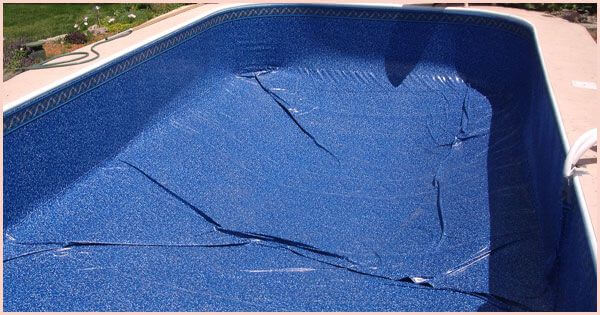
When the water gets below 6″ above the floor of a pool, the liner begins to relax, away from the walls. If your pool loses more water, to the floor – the entire liner will relax and wrinkles will set in. The water loss can be accidental, in the case of a leak – or it can be drained intentionally, to correct poor water conditions. In either case, when the water gets too low in a vinyl liner pool, some care is needed to re-set the liner to prevent wrinkles. When liners are especially old and brittle, resetting can cause the liner to snap or break. Avoid draining vinyl liner pools, especially when the vinyl is showing some age, to prevent the sometimes unavoidable wrinkles or damage to the pool liner.
How to avoid wrinkles when installing a new liner:
- Line Up the Corners: Some liners are marked, others you’ll have to follow the seams to make sure the corners line up.
- Even the Drape: Often pool liners tend to slide into the deep end. Sand bags or water tubes are used to hold it to the shallow wall if needed.
- Set with a Vacuum: Average pools use one Liner Vac or Wet/Dry Vac; larger pools need two. The Vac ‘sets the liner’, or removes the air between the liner and walls/floor, to keep the liner wrinkle-free until the water level is about 6″ above the floor, at which point it can be removed. Duct tape is used to seal up the hose going behind the liner and down the wall, the skimmer and the step section.
- Push & Pull the Vinyl: You can also use a large brush on a pole, to help hold areas taut until the vac suction takes hold. It often takes many attempts before you are able to work out all the wrinkles, by pushing and pulling them towards the pool edges or just smoothing them out. If the vac suction sets the liner with wrinkles, shut off the vac, and make another attempt at working out the liner wrinkles, until you are able to get them all.
- Wait to Cut the Vinyl: The main drain ring and cover is placed first, with just 6″ of water in the pool. But steps, lights, returns and skimmers all have to wait until the water level is up to the bottom of them. If you install the faceplate screws and trim before the vinyl has stretched fully, it can cause liner wrinkles, or can open up the screw holes into leaks.
Once the liner is installed…

After a new pool liner is installed over the wall (overlap liners), or snapped into the track (beaded liners), you should work out any floor wrinkles by “banging” them towards the side of the pool. Use a pool brush or push broom, or your hands to slowly work the wrinkles to the edge of the pool. Do this from up above, on the pool deck, or standing on the outside of the pool.
If you are using a vacuum to set the liner, the trick is to hang over the edge of the pool, shown right, and grab up the liner in both hands, giving it firm pulls toward the wall. Work your way around the pool, pulling any floor wrinkles toward the side.You may need to turn the vac off and on, while you work out the wrinkles in the liner, pulling them towards the side. It’s best to do this work from outside of the pool, not inside the pool.
How to remove pool liner wrinkles:
- Small Floor Wrinkles: Remove half the water, but leave a few inches of water in the shallow end.Use a pool brush or toilet plunger around the area, as well as ‘scuffing’ the liner with bare feet, to try to push the wrinkle towards the nearest wall.
- Large Floor Wrinkles: If the vinyl is folded over more than 1/4″, and they run horizontally across the floor from side to side, you may want to drain the entire pool and reset with a vacuum, after pulling the liner back up into the shallow end.
- Wall Wrinkles: Often these occur when the liner is twisted slightly in the track, or the corners are not lined up properly. Try to push the wrinkles toward the space in between the wall and floor by working with a floor squeegee, or just your hands.
If the pool is already full, try first with your feet. Wearing some soft rubber sole shoes can be helpful, but be careful not to kick the liner too hard. The idea is to spread out the wrinkle, into the surrounding area, or toward the wall, where the slack can be picked up in the area between the wall and the floor.
Lowering the water level down to just above the floor, removing much of the water weight, can be helpful – it makes the wrinkles easier to move. But again, try not to go too low, or you may risk more wrinkles appearing in your pool liner.
Wrinkles are always easier to remove when the water is warm, and when they haven’t been in place for too long. If the wrinkles have set-in for many months, especially under winter water temps, they may be nearly impossible to remove. Not all wrinkles can be removed, sorry to say. Maybe you can live with them for a season or two – if not, you may need to replace the liner.

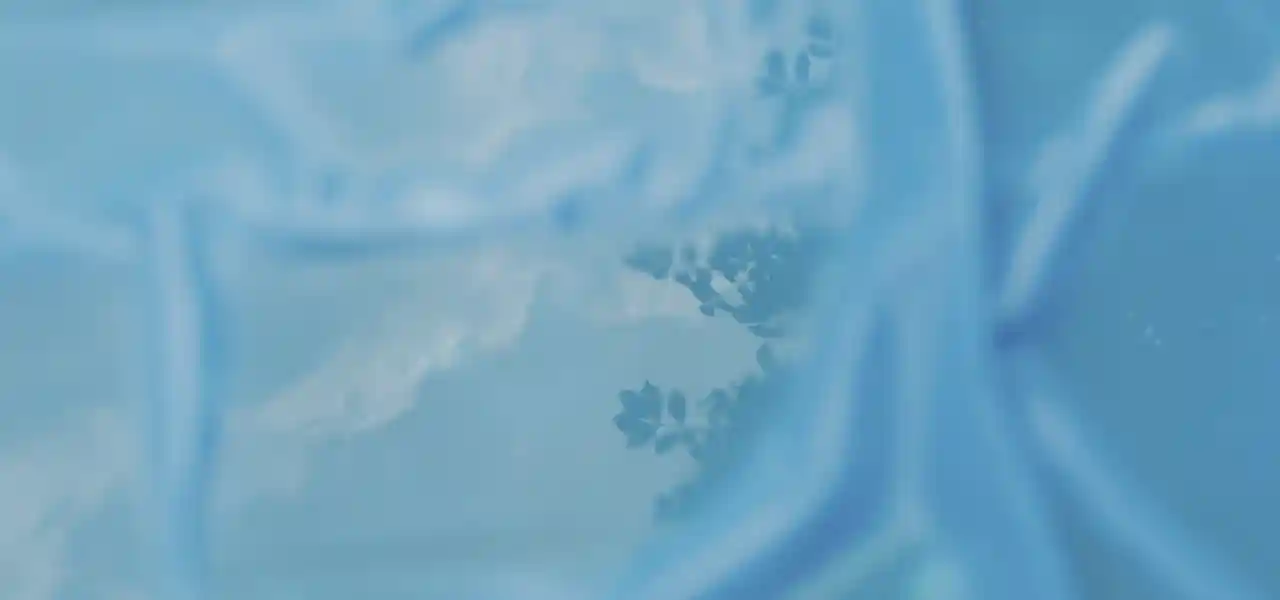
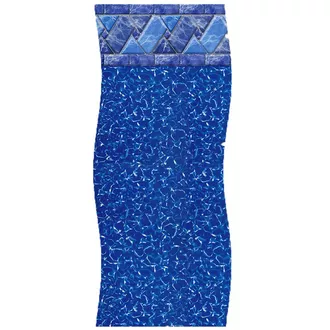
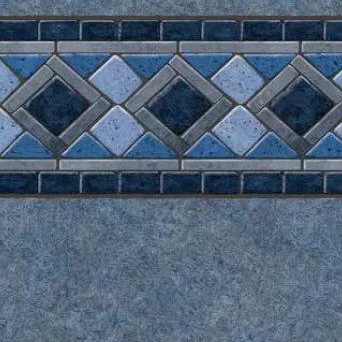
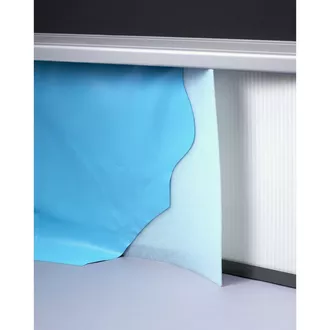
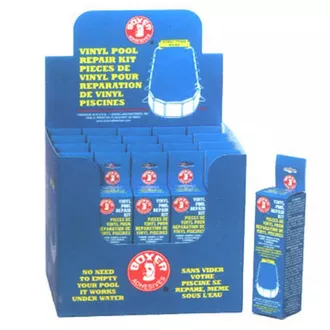
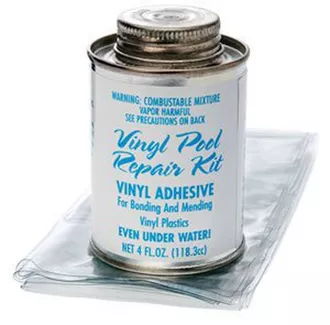
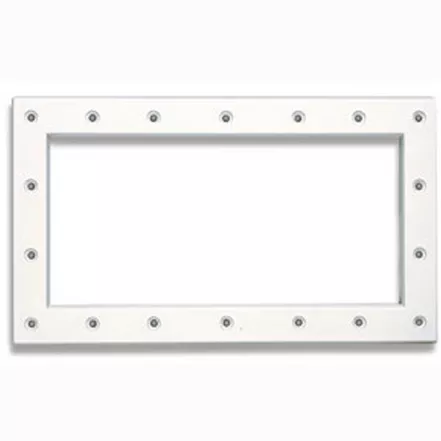
Hi Davy,
I just had my vinyl liner replaced in my 16x32x8 in- ground pool. I wish it was done earlier in the year, but the installers were in high demand due to the lockdowns and new pool installs.
Anyway, all went fairly well except there are about 6 two foot long wrinkles that are no more than 1/4 inch to 1/8 inch big. Three vertical on each side of the deep end. The installers got them into the corners and half way up the wall and were hoping the fill would stretch them out. But it being October and very little give, it didn’t turn out as hoped.
Is my situation bad? What can I expect of this flaw? can anything be done? Should anything be done? Are these going to be permanent? Will they work themselves out? or will next years heatwave allow me to work them out?
Thanks
Hi Scott, it’s hard to say for certain, but I can imagine three vertical wrinkles, on the side walls, 2 ft long, on each side of the deep end. To me, that sounds like a liner that is a little bit too small for the pool, or a liner that is pulled too far into the shallow end, when it needs to shift towards the deep end. It may be able to be worked out if the pool was emptied on a warm day. But if it sits all winter, the liner will probably have a memory and wish to stay that way. Wrinkles on the wall are better than on the floor, but even on the wall, a fold in the vinyl is a weak spot, that may develop cracking (over the long term, 8-10 yrs), and could get snagged by pool tools or sharp toenails (!). Clearly not your fault, sounds like you are trying to be understanding, but they messed up, and should reimburse you, or reinstall it next year. Overall, the liner will still function, but if it was me, I’d ask for a 20% refund, if you are willing to live with it.
Hello,
I have a 20’x40′ pool. The previous owner filled in the deep end so it is all 3′ deep now. The filled in part was gravel and he covered it with cement, but not smooth. The original shallow end is a smooth, poured cement.
My liner is wrinkled, with all wrinkles perpendicular to the long dimension the pool, ONLY on the side of the pool with the smooth cement bottom.
The liner is not wrinkled at all on the filled in side with the rough, uneven cement bottom. The liner there just follows the rough, wavy nature of the cement floor.
The wrinkles started a couple years after getting a new liner. They have multiplied, and some stand up at least 1/4″, but they are only on the side with the perfectly smooth floor.
What has happened and how do I avoid this for the next liner?
Hi Jon, interesting… very well described, I understand. Why would the wrinkles be only on one end of the pool. when it’s all the same depth? My only thought would be water under the liner, raising the liner, but only on the one side, water is able to come between the pool walls/floor and the liner, and ‘float’ the liner, or raise it up off the floor, and when it comes back down to rest, it wrinkles, because raising it has caused the liner to pull or slip inward, and because the liner was stretched, under the ‘hydrostatic’ pressure of the water. Have you ever seen the liner floated, or ‘perched’ before? If that theory is correct, you may be able to verify when you drain the pool, if you see moisture in-flow. But many times, a floated liner only happens during large, extended rain events, when the water table and rises very rapidly, and traps water beneath, or up against the pool. To correct the situation, if you believe my theory, you’d want to consider the storm run-off around the pool, both above and under ground. Adding underground ‘french drains’ or open drains, combined with swales, and grading a pitch, to direct rain water as fast as possible, away from the pool, before it can sink into the ground. Secondly, you could add drains in the pool floor, a regular main drain pot, that is placed on top of a 3×3′ gravel pit, encased with a few inches of concrete. In the drain pot, you would install an automatic hydrostatic relief valve, a spring loaded cap to let high water table come into the pool, when the hydrostatic pressure is great enough to open the valve. You could even place more than one, 6 ft apart. These could be tied into your filtration system too, if you wanted to juice up the circulation, or not, they can function only as hydrostatic relief valves, inside of a main drain pot.
I was able to push it down the wall to the corner of the floor but it really seemed to disappear before even making it all the way down the wall. Gonna keep checking to make sure it doesn’t come back before we close it up for year in a few weeks.
Hello, our may 31 2018 Latham liner came out of the track in a corner. It went below the water line. Pool water filled in behind the liner and made big veins all over the pool. I put the liner back in the track. The water veins dissipated and we are left with wrinkles every where. Liner installer came out to view and said its due to over chlorination. We a second opinion. The technician said the liner is to big and not the correct size. The liner is very loose in the one corner of the oval pool. I t gets the most sun. What do you think?
Thank you, Andrew Spiterie
Chlorine damage to a vinyl liner has a telltale look, very puckered, not a clean wrinkle, but … puckered like old wrinkly skin or kind of like an orange peel? If you google it, you may find some pictures of chlorine damaged vinyl. A liner that is too big will cause the liner to come out of the track, and can be fixed with Liner Lock. For the wrinkles, you can lower the water level and likely push them out – spreading the wrinkle out and pushing and pulling it flat again. But don’t wait too long, or the vinyl will develop a memory of the wrinkle, making it hard to remove.
We had our inground pool installed last year. We just discovered a spongy feeling wrinkle on the wall about 2 feet below the water level in the shallow end. Can this be taken care of without removing the water? We have very sandy land that almost never puddles and generally has fantastic drainage. Also at the top of that wall the top of the liner has always felt spongy like there is air trapped, not sure if that is related.
Ken, that water is either from the outside or the inside. Meaning it is water that has come into the pool from outside, and was pushed under or over the wall, and came to rest between the liner and the wall, or, water from inside the pool managed to splash into a void where the top of the wall and liner meet. The air may be related. Now to deal with this… normally when on the floor, they just subside after some time, usually as water table recedes. So you may want to wait a week or more, and then I wonder if you may be able to sort of ‘squeegee’ the water up the wall and out from behind the liner at the top, removing the liner bead from the track. Using a large, flat object, or floor squeegee perhaps. It will help to lower the water level in the pool, and be much easier if you can take out the full 2 ft of water, then you can use a shop vac, with a very thin attachment. Afterwards, pop the liner bead back into the track and monitor.
Hi, we had a new liner installed last year. No problems at all with the liner. This year, after two weeks of opening our pool, I noticed several ripples in the shallow end. I am able to use the pool brush and gently push them into the deep end (8ft deep end). The liner can be free of ripples for days or sometimes a week before they come back and I have to do the whole brushing them into the deep end again.
Our pool guy said it has nothing to do with the installation and that it is a cause of ground water. He said we need to install a pump so that we can get the water out so that it doesn’t go behind the liner. I have also noticed that the bottom perimeter of the pool is spongey which has me believe that it can be the ground water getting in behind the liner.
What’s the best advice for a problem like this? I am worried that over the winter these ripples will form and come next spring I will not be able to brush them into the deep end like I am able to do now. The liner is dark and the ripples are quite evident. This wouldn’t bother me as much if the liner was old and going to be replaced soon but it’s brand new so I want to be pro-active about solving this issue.
Hi Nella, water is a likely cause, yes. For those reading along at home, water may build up under the liner, stretching it and ‘inflating’ the liner, during a large rain event. When the water table recedes, the liner comes back down, but a little stretched out, and so wrinkles appear. Most pool guys call this a ‘floating’ liner. What can you do? Maybe nothing, but probably something! You want to direct water away from the pool, this may be easy, it may be hard. It starts with understanding how water flows around the pool during rain events, and how to water flows underground. This can be manipulated and changed, with earth moving equipment, or sometimes just a shovel. Sometimes, the drains and gulleys are clogged up, those that used to carry water away from the pool, but now do not, so quickly anymore. Repair will likely involve some French Drains underground, lots of gravel, or aboveground swales and gulleys. It may involve cooperation from a neighbor. Or, in some cases, the ground is flat all around, and you are at sea level, and short of covering the entire backyard in concrete, there is little to be done. But if you have some topography around the pool, something can likely be done to improve stormwater run-off, and keep it moving, away from the pool, or, stop the water from getting stuck under the pool. Again, this may be easy or it may be hard, but there is likely something that can be done to improve the terrain and storm run-off around the pool. As your pool guy mentioned, there are also underground de-watering methods that can be used, like a sump pump in a dry well next to the pool, or a sump pump in a gravel pit under the shallow end, or a main drain pot installed in the shallow end, with a hydrostatic relief valve, to let the water into the pool. I wrote a little bit about it. Storm Water Management and Inground Pools and Inground Pool Construction and Groundwater Issues
Hi!
We had a mineral system pool installed last summer/early fall. It is a sport bottom pool, and we have noticed a few small wrinkles on each of the shallow ends. Nothing major and can’t feel air in them, they look like little folds in a couple of spots. Is this normal, or does it need to be addressed?
Thanks!
Hi Margaret, not really normal, but nothing you can really do about it either, unless you want to drain the pool and try to push the wrinkles to the edge, but it may be too late, as vinyl tends to develop a memory of such things. Just try not to notice it, or worry about it. And use care in cleaning that area, so as not to snag the fold and create a hole, or abrade the fold over time.
Hi there,
I bought a house two years ago that had a two year old liner – in ground pool built in the 80’s or 90’s. The first year I found this horizontal jagged edge in the deep end about half way down the slanted part heading to the floor. This year when I opened up the pool I found two more issues. There is a ton of wrinkles that were squishy but are hard now – water level inside the pool has been fine no indication of leak. Second issue on the other side of the deep end Wall about half way down the slanted part there seems to be two bolt heads that are starting to poke the liner – I can see them with goggles and feel it with my hand – very defined bolt head.
From all the reading I have been doing, I found that the slanted part in the deep end is usually concrete or vacumite – why would there be bolts on the walls of the slanted part? And what could be causing the jagged edge on the other deep end wall? It’s about 4ft in length.
Thank you!
Hi Lindsay, bolts in the pool floor is not normal, I can’t think of what that might be, but the wrinkles and jagged edge may give a clue, if the liner is prone to ‘floating’, from a high water table underneath the pool, which pushes up the liner after heavy rains – the bolts could be related to a de-watering effort in the past. Some sort of drain installed under the liner? I can’t really picture the jagged edge, I suppose you mean under the liner, in the floor. It could be where water has caused the (sand) floor to slump, or expose something else under the liner.
Hello, we have an above ground pool. We just noticed today that the liner is loose with air behind it above the waterline and appears to be twisting slightly. It is the beginning of a heat wave so not sure if that çould have anything to do with it. Also there was a small hole behind the ladder which we patched not sure if that might have anything to do with it either. It is 6 years old. The liner doesn’t seem to be detached at all just baggy ahove the water line all of a sudden. Thanks in advance for your advice — really appreciate it 🙂
Hi Anny, is it an overlap liner? Where the liner over-laps the pool wall, and you can see a little bit of it on the outside top of the wall? In such case, the coping strip may have come loose, so you can pull the liner down, standing outside of the pool, and then reaffix the coping strip.
Help! My above ground pool sat in about a foot or more of water as a result of the south Louisiana major flood of 2016. When water subsided The entire pool liner wrinkled — badly. This was so sudden and too extreme to be a consequence of chemicals or the balance of the pool. I have had controversial conversations telling me that that wouldn’t have done anything. But if water sat under the “bed” that was laid for the pool to sit steady on —and then water was at least a foot deep for a couple of weeks then I feel like the standing and subsiding water must have compromised that sturdy bottom totally wrinkling the liner Don’t k know? Is the only option to buy a new liner and totally redo the bed underneath?
Hi Joanna, you’re talking about water UNDER the liner, right? We call that a floated or floating liner. Not very common but can happen, when water and hydrostatic pressure builds up under the pool. In many cases, the liner will reset with no problems, but if big enough it will stretch and shift the vinyl, and if you have a sand floor, instead of vermiculite or cement, then the floor is gonna get all messed up, and the liner won’t fit right again. As you guessed, you can live with it for a few years, but if you want it to look nice, it’s a complete liner and reworking of the sand floor, or replacing sand with a sand/concrete or sand/vermiculite, or full concrete, or stone dust, or hardened sand (chemical sprayed over the troweled sand), if that is in your budget. A new liner will cost $900-$1250 usually, if bought online. Or double that if purchased locally. Total job is about $5K usually, from a company, or $2K if you DIY, with a few laborers and supplies.
We have an in-ground pool. Last year we had a new liner installed. Had no problems all season. We have had our pool for 20 years and this is our 3rd liner and we have never had a problem in the past. After our pool was opened last month, we noticed wrinkles on the bottom and one on the wall. Now I noticed another wrinkle in the deep end. Our installer said there is nothing they can do and said we must have a water problem underground. We have NEVER had this problem. Not sure we where go from here. It will cost us $650 to stretch the liner and refill the pool but there are NO guarantees. What should we do? We live in Charlotte, NC.
Hi Karen, wrinkles like these that appear after years, for seemingly no reason, are usually underground water, which balloons the liner, like a bubble underneath and when the water recedes, because it has stretched, it now has a wrinkle. What you should do is find out what has changed in the last years with storm water drainage around the pool. It might be a clogged drain, or a deck or yard area that no longer drains, or other intake or outflow problems that put a lot of around the pool. Perhaps you find nothing, but see if there is something you could do, with french drains and pot drains, or swales, to channel water away from the pool. It takes a close look to see what can be improved, on the intake and outflow sides of the pool, to reduce the amount of water brought up against the pool. I would not try to drain and fix, I don’t think its possible for those on the floor, the wall wrinkles, maybe. Just live with it for a few years, and work on improving drainage. For flat areas, you could even consider a dry well next to the pool, which has a pump underground, connected to a pipe in gravel, to pump water away from the pool in the deep end area, or installing intakes into the deep end, with automatic hydrostatic relief valves on the pool floor, to let ground water into the pool.
Hello,
My inground pool needed to have the shallow wall repaired. So we drained the water out of the shallow end and let some of the liner out so we could get the wall repaired. We placed the liner back in track and it was stretching yesterday (it was a hot day) and now it’s raining. As we were filling this morning the one corner seems really tight and the liner doesn’t seem flush to the walls. Our pool guys said to continue filling on a hot day and the liner will stretch to the walls. Should I be worried that something is wrong?
I would continue filling, corners are typically tight like that. Be sure to put some wedge or shim into the track to help keep the bead from popping out of the track. The liner may not touch the wall at all, above the water line, that is not unusual.
I just had a 18×33 above ground pool installed. The wall was falling in so the installer said to remove all but 11″ of water and wait for the sun to stretch it, it didnt work that way but it was repaired. Since it was mid March in PA , the installer said to wait until we get few sunny 70 degree days to fill the pool up. He told us to not put water in, it was empty for over 4 weeks. When we filled it and dirt collected on the bottom we could visibly see large wrinkles and a 3/4″ fold almost the entire length of the pool. Can the liner be stretched to make the wrinkles and fold go away?
Hi, the pool would need to be drained in order to restretch the liner and pull out the wrinkles. Do it now, or the vinyl will develop a memory and be hard to remove the wrinkles and fold. While filling, as you get 3-4″ of water across the bottom, you may need to actively work the liner, to push wrinkles to the edges. If needed, use sand bags or soft weights to hold the liner against the wall, if it wants to snap-back to the ‘memory’ of a wrinkle.
Hello
Can these wrinkles on the wall occur within tow months of installation and conintue to grow even pool chemistry is correct .
Hi Steven, that’s unusual for wrinkles to appear ‘under-water’, but it can happen. If your pool is aboveground with an overlap liner, it may be slipping down the wall. If you have an inground pool, something more complicated may be occurring, not sure exactly what. Chemical wrinkling can happen, but is usually evident from the puckering it causes, often accompanied by discoloration.